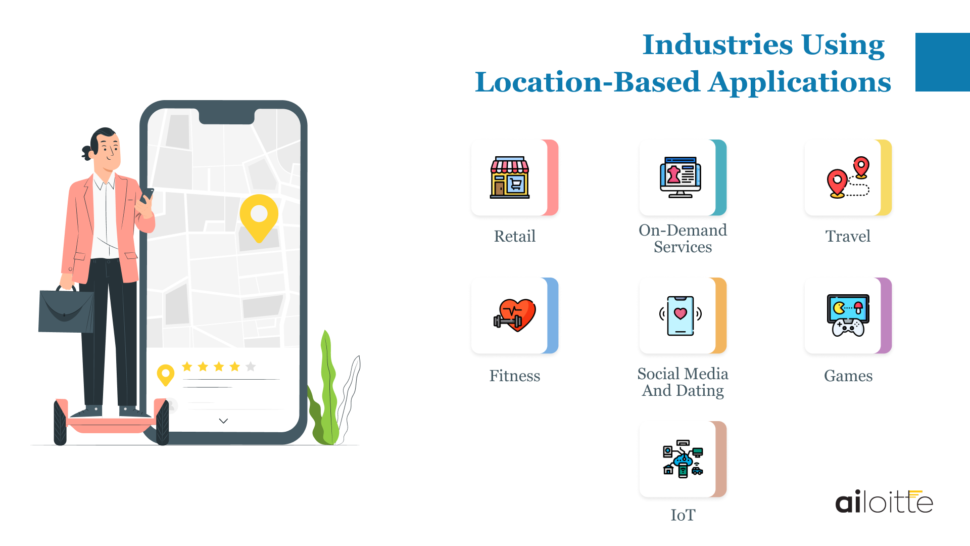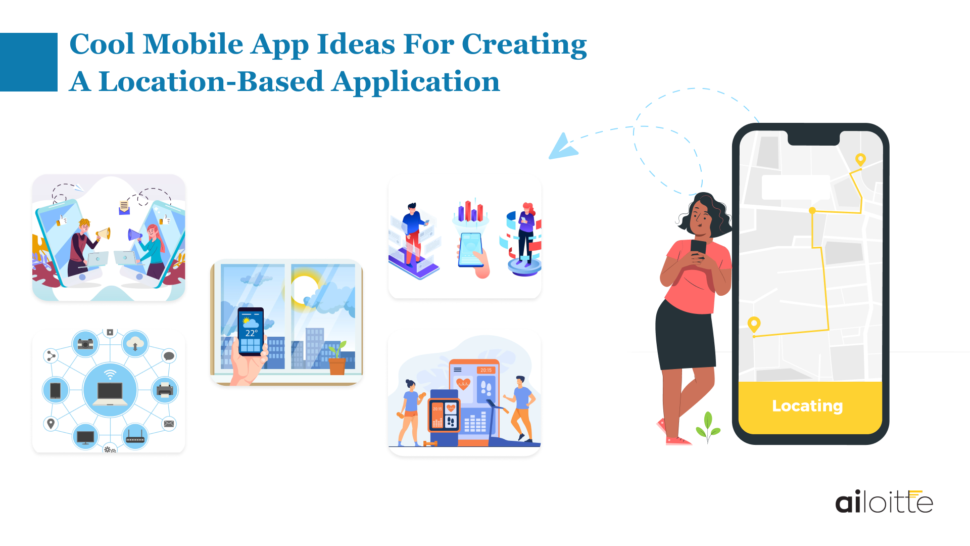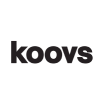Location-based apps have been trending for the past few years.
The main feature of location-based apps is detecting the user’s current location but the impact it creates through customizing the business’s solution based on it, like providing geo-specific services, targeting location-based products and recommendations, promoting their brick-and-mortar stores, and more, leaves profitable business impact.
According to Allied Market Research, the worldwide market for location-based services is expected to reach $318 billion in 2030, with a projected CAGR of 24.3% between 2020 and 2030. Considering the number of smartphone users, developing an app with geolocation can expose the business to 200 million potential customers in the USA alone.
With stats like these rolling in daily, now is the time for your app to gear up and be ready to claim a stake in the location-based apps market.
Before we dive into how to make a location-based app, let us know what location-based apps are, the types of location-based apps, how to build a location-based app, some location-based service examples, and finally, some cool ideas for apps.
What are location-based Apps
Location-based apps collect data about the user’s current location and offer customized services. They don’t just track a user’s location and provide information about objects nearby and directions, but they also suggest relevant destinations and offer valuable details about them with the help of a GPS, Cell ID, or Wi-Fi.
Some of the key functions of a location-based app are –
- Information: Provides the user with all the info they need about the nearest locations where the product/service is available.
- Social: Users can find other people or events nearby their locality.
- Communication: Businesses can register a place on the map; users can leave feedback or review others’ ideas and link the content to a specific place on the map.
- Marketing: Businesses can target marketing campaigns location-wise to improve penetration.
Types of location-based Apps
Here are some types of location-based applications.
- Real-time applications: Apps such as Uber track the driver and customer while providing service.
- Map-based apps: These apps show the map when using the applications such as Uber, Grubhub, and Google Maps, which show the user’s location and directions on the map.
- Geofencing apps: Apps that use geofencing are location-based such as TripAdvisor which shows restaurants, hotels, and points of interest based on the user’s current location.
Now let us see how to create a location-based app.
How to Create an App Like Uber and Lyft?
Location Based App Development: How To Build A Navigation App
The following are the steps that you must approach for creating navigation apps.
1) Study the market and explore opportunities
It is important to begin researching similar geolocation apps currently in the market and their unique features. Use this info to find the expected gaps in your competitor’s app and try to serve a complete solution to the problem you are trying to solve.
Next, read the reviews of those apps, research existing market leaders in the domain, talk to a few potential users and understand their expectations. Once you do competitor and user research, shortlist potential benefits of the app that will appeal to your customers and set you apart from competitors.
2) Select a reliable mobile app development company
The success of your app depends on the geolocation app development company you choose for your app idea to become a possibility. Finding the right partner can be time-saving and cost-effective as you need not worry about paying salaries, taxes, bonuses, equipment, etc.
However, it is essential to consider the following
> Opt for an app development company with the right expertise and a convincing portfolio in the domain and download the apps to measure usability.
> Check if the development company has expertise in the platform on which you wish to launch your app.
> Location-based app development costs may vary depending on the company you choose. Ukraine and India have the lowest development rates, closely followed by the USA and UK. The average cost can range from $30,000 to $100,000 as per app complexity and features.
3) Create the UI/UX design of the app
Once you decide on the app’s features, it is time to create a visual prototype. Start working on the app’s appearance, colors, typography, fonts, etc., and what screens you wish to include. This can help validate your idea.
4) Selecting the right technology stack
The location-based app tech stack is determined by which app platform you wish to target, like iOS, Android, or Web, and the objectives you have.
Adding the correct location-based SDK (software development kit) can help your app access the right and accurate location data from the user’s device. For example, maps based on Google Maps and Apple MapKit for iOS. In addition, many location-based technologies and other frameworks, such as OpenStreetMap, Map Box, etc., are used to add more location-based features to the app.
5) Decide on the functions
The key location-based app features that you must include are the following.
- Map view
- Route mapping
- User-location detection
- Location-based notifications
- Location History
- Places near me finder
You can also add additional features depending on the purpose of the app.
- Setting the radius
- Ratings and recommendations
- Location search by photos
- Real-time updates
- Weather forecasts
- Location shares with contacts
The number of features to be added should be kept at the bare minimum for the app’s initial version. It is advised to build an MVP first and prioritize your features based on users’ feedback.
6) Release and maintain your application
After the tests are complete and your app complies with the App Store and Google Play Store rules, it is time for release. However, it is critical to note that the work on your application will continue. To keep the software relevant, you need to constantly add new features, improve the app based on analytics, support, and maintain it.
Industries using location-based applications
The following are industries that have been benefiting from location-based service apps.

1) Retail
Most leading retailers, like Walmart and IKEA, use geolocation tracking apps to augment their in-store experience. For example, they use your GPS data to help find the nearest store or choose a convenient pickup or delivery location.
2) On-demand services
Most on-demand transportation apps, such as Uber, rely on user location to pair them up with the nearest drivers. It also allows the users to see where their taxi is when it arrives, monitor their status, and get an estimated travel duration – all in real time.
3) Travel
No hotel booking app is complete without a map view. Finding their nearby hotel/specific destination is very convenient for users, and this feature can be handy for last-minute bookings, finding the location of tourist spots, etc.
4) Fitness
Access to the phone’s GPS data can help apps map routes, track speed, and even connect with fellow fitness enthusiasts in the area. In addition, using geolocation in the app, the nearest fitness studios, personal trainers, and local feeds can be viewed in the fitness apps.
5) Social Media and dating
Apps like Instagram and Snapchat have a map view that allows users to geotag on posts to see people nearby and connect with them based on location. In addition, dating apps like Tinder use geolocation to enable communication with users nearby.
6) Games
One of the most popular games of all time, Pokemon Go, PUBG makes excessive use of geolocation and is often touted as one of the best location-based apps.
7) IoT
In addition to the above listed, IoT uses geolocation the most in wearables such as smart watches, safety care apps, pet care apps, etc., and also on luggage with GPS-enabled devices such as LugLoc.
Looking at the industries that successfully use geolocation ideas, it may seem there is no longer a new use. However, with the potential of location-based apps greater than ever, the following app ideas for beginners can help.
Cool Mobile App ideas for creating a location-based application
Despite a massive number of apps that use geolocation across various industries, there is untapped potential that is worth your attention. Here are some cool location-based app ideas that you can work on for your business.

1) Recommendation apps
Most location-sharing apps know the most-visited places of individuals. So you can build a location-based app that shares your top favorite places for a specific type of activity. Such apps can succeed in fields like fitness, events, and dating.
It is likely to grow among its audience, considering there are very limited competitors in the market.
2) Augmented Reality
This has already been used in mobile games, but this technology can enrich many location-based apps in other industries.
For example, navigation and tourism are among the most popular augmented reality use cases. Imagine if your customer could just scan the surrounding area with a camera for information, from historical facts about the city attractions to recommendations and guides about the nearest and best stores or places.
Some other use cases of AR in location-based apps include:
- It can also be used in the retail industry as a part of quality services for working with clients. For example, it helps users search for a specific product and get the products with their location, price, review, and discounts.
- In real estate, AR can be a solution for clients to save time by viewing houses and apartments in full detail in a 3D view which can increase the likelihood of making better deals.
3) IoT apps
The prospects of the growth of IoT are almost limitless owing to the number of gadgets and solutions that already have access to GPS. Custom solutions can make your home technology efficient and turn on the light or launch specific tools, such as a thermostat, when an owner enters the home. The user can also get alerts when someone enters or leaves the house.
Businesses looking for location-based app ideas in the IoT sector have enormous potential because consumers are ready to spend money on making their lives comfortable.
Recommend link – Emerging IOT Ideas and Business Opportunities
4) Health and Fitness Apps
According to Coherent Market Insights, the global market for health and sports is anticipated to have a tremendous CAGR of 20/4% from 2019 – 2027.
The health and fitness app should allow users to create an account, set their targets, notify them with updates, track progress, integrate wearables, etc. On that front, geolocation can help track users’ daily activities, such as running, cycling, swimming, etc., and provide overall progress.
A good health and fitness app is always in demand. Adding features such as geolocation can make yours an attractive app.
Recommended Link – Healthcare App Development: Guide
5) Weather apps
It will be nice to know what weather to expect for the day in your area. That can help you plan what to wear for the day or decide whether to keep an umbrella handy.
Geolocation is a helpful feature with your weather app, particularly for those constantly moving around and traveling. Besides current conditions, apps with short-term forecasts or send alerts regarding impending storms, tornadoes, hurricanes, or heavy rainfalls to be mindful of can be considered.
Summing up
Geolocation is an invaluable feature that can be added to the development of most types of apps. It has many benefits when used in apps created for different industries and sectors such as healthcare, marketplaces, media, travel, etc.
Today, most modern applications are location-based as it helps users to find information about upcoming events and meetings—local news, updates, etc.
Our recent client Shop Avenue wanted to improve its online presence with a kickass website and app. In addition, they wanted a brand-new identity within 3 months. We helped rebrand their UI/UXUX and deliver a responsible multi-platform location-based app. After release, the number of downloads increased to 20,000 in under 60 days and ratings went up to an average of 4.5*.
If you have an idea for a location-based application or are searching for a mobile app development company, contact us as we have plenty of years of hands-on experience in developing location-based apps like the ones above across multiple verticals.
FAQ’s
To build a location-based app, first do proper market research and finalize the niche. Then hire a development team or company to develop your app. Finalize the featured list and create eye-catching UI/UX designs. Choose the desired technologies based on the target platform and build the app. Once it is ready, test the app, then deploy your location-based app to app stores.
There are numerous location-based services such as Waze, Google Maps, PokemomGo, Lyft, Uber, GasBuddy, and WhatsApp.
To create a location-based app, first study the market and analyze competitors, build a Prototype, incorporate GPS geolocation into the app, develop and test the app. Reiterate and release the app on app stores.
Location-based apps use a smartphone’s GPS technology, cell tower data, or Wi-Fi to determine the device’s whereabouts.
Building a navigation app can range from $30,000 to $100,000.
On average, navigation apps can take between three and nine months to develop, depending on the structure and complexity of the app.



















.png)
.png)
.png)



Leave a Comment